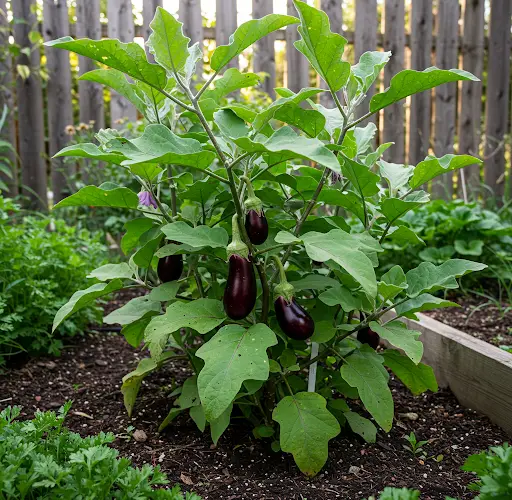No Garden Needed: Grow Eggplant at Home With High Yields
You don’t need a backyard garden to grow delicious, healthy vegetables. With the right method, you can grow eggplant (also known as aubergine or brinjal) right at home—even in a small space. This productive and low-maintenance plant thrives in containers and can yield plenty of fruit with the proper care.
Whether you live in an apartment, have a small balcony, or just want to grow fresh food close to your kitchen, this guide will show you how to cultivate eggplant at home for a bountiful harvest.
Why Grow Eggplant at Home?
Eggplant is a nutrient-rich vegetable packed with fiber, antioxidants, and vitamins. It’s versatile in cooking, from grilled slices and stir-fries to stuffed dishes and stews. By growing it yourself, you’ll enjoy better flavor, fewer chemicals, and the satisfaction of harvesting your own food.
Even better, eggplants are ideal for container gardening. With a compact root system and an upright growing habit, they’re perfectly suited for pots and small vertical spaces.
What You’ll Need
To get started, gather the following:
-
Eggplant seeds or seedlings
-
A pot or container (minimum 12 inches deep and wide)
-
Potting mix rich in organic matter
-
Compost or organic fertilizer
-
A sunny spot (balcony, window, or patio)
-
Support stakes or a tomato cage (optional)
Choose a compact or dwarf eggplant variety if you’re working with limited space. These types are especially well-suited for containers and tend to produce earlier.
Step-by-Step Guide to Growing Eggplant at Home
Step 1: Prepare Your Container
Select a container with good drainage. Eggplants need space for roots to grow deep, so a pot that’s at least 12 inches in depth and width is ideal. Fill it with a quality potting mix blended with compost to provide nutrients and retain moisture.
If using seeds, start them in small seedling trays or directly in your main container. Keep the soil consistently moist until germination occurs (usually within 7–14 days). If you’re using nursery seedlings, transplant them into the container when they’re about 4–6 inches tall.
Step 2: Choose a Sunny Location
Eggplants love warmth and light. Place your container where it will receive at least 6–8 hours of full sun each day. A south-facing balcony, sunny window, or rooftop spot is perfect.
Step 3: Watering and Feeding
Water your eggplant regularly to keep the soil evenly moist, especially during flowering and fruiting. Avoid letting the soil dry out completely or become waterlogged.
Feed every two weeks with a balanced organic fertilizer or compost tea. Once the plant begins to flower, switch to a fertilizer with more potassium and phosphorus to support fruit development.
Step 4: Encourage More Fruits With Proper Pruning
To increase your eggplant’s yield, pinch off the top of the main stem when the plant is about 12–15 inches tall. This encourages bushier growth and more flowering branches.
Also, remove any yellowing or damaged leaves and suckers (small shoots that grow at the junction of stem and leaf). This directs the plant’s energy toward fruit production.
Step 5: Pollination and Fruit Set
Eggplants have self-pollinating flowers, but you can boost productivity by gently shaking the plant or using a soft brush to transfer pollen between flowers. This is especially helpful in indoor or balcony settings where there are fewer natural pollinators.
Once the flowers are pollinated, small fruits will begin to form at the base of the flower.
Step 6: Support and Care
As the fruits grow, the branches may get heavy and bend. Use plant ties, bamboo stakes, or a tomato cage to support the stems and prevent breakage. This also helps keep the plant upright and well-aerated.
Watch out for common pests like aphids or whiteflies. If needed, spray with a mild soap solution or neem oil to keep them under control.
When to Harvest
Eggplants are usually ready to harvest 60–80 days after transplanting. Pick the fruit when it reaches a glossy, deep purple color and is firm to the touch. Don’t wait too long—overripe eggplants become bitter and tough.
Use a sharp knife or garden shears to cut the fruit with a short piece of stem attached. Regular harvesting encourages the plant to produce even more.
Tips for Continued Success
-
Re-pot yearly if growing as a perennial in warm climates.
-
Save seeds from mature fruits to grow future plants.
-
Mulch with dry leaves or straw to retain moisture and reduce weeds.
-
Rotate crops or change soil if replanting in the same container to avoid disease build-up.
Final Thoughts
Eggplant is a fantastic crop for small-space gardening. With just a pot, some soil, and sunlight, you can enjoy a steady supply of this versatile vegetable throughout the season. Whether you’re growing on a balcony, windowsill, or rooftop, this method offers a practical and rewarding way to eat fresher, healthier food straight from your home.



